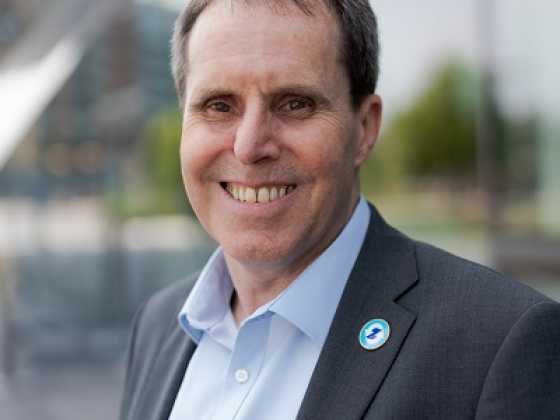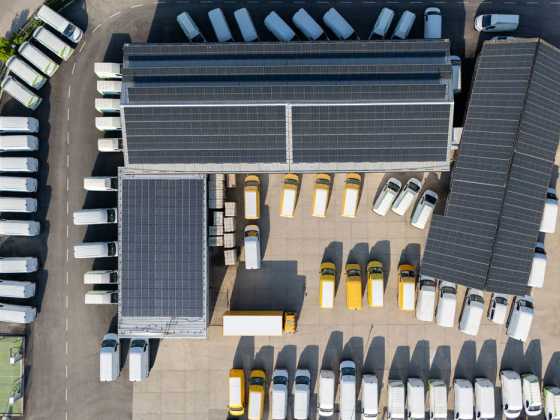Panel of Experts: Road to Zero

As interest in electric vehicles grows in the fleet sector, our expert panelists discuss how to get around “charge anxiety”, as well as advice for adopting electric vehicles and installing charging infrastructure for a fit-for-future fleet
Expert panelists: Lee Brown, head of 0Zone, The Grosvenor Group; David Butters, general manager for E.ON Drive / director of E.ON Infrastructure Services; Colin Ferguson, CEO and co-founder, The Algorithm People; Gavin Franks, director of business services, the AA; and Matthew Walters, head of consultancy services, LeasePlan UK. Biographies below.
2021 was the most successful year to date for electric vehicle sales. Confidence in electric vehicles is growing as more models come onto the market, with increased range. But now a different type of fear is acting as a barrier to adoption, with some arguing that ‘range’ anxiety has been replaced by ‘charge anxiety’. This is a fear that the fragmented and sometimes unreliable nature of the public charging network will hamper charging.
It is something that the government is trying to address; in its recently published its Electric Vehicle Infrastructure Strategy, it says that chargepoints can sometimes be difficult to find, difficult to use and may turn out to be in use or broken when a driver reaches them. Even paying for electric vehicle charging can be unnecessarily complicated.
It stipulates legal requirements on operators that will enable electric vehicle drivers to pay by contactless, compare charging prices and find nearby chargepoints via apps.
So what are the problems of the public charging network currently, and how can they be improved?
Colin Ferguson, chief executive officer at the Algorithm People shares his thoughts: “The ability to book or reserve public infrastructure, would make a huge difference to anxieties around charging. Whilst there are many good sources of active chargers, there is still a problem with ones that may be offline, which doesn’t help when this infrastructure is a key part of your itinerary.
“Planning your journey in advance where possible, considering multiple potential charging options enroute, and also looking at other energy solutions, all mitigate ‘charge anxiety’, but doesn’t replace arguably, the ultimate solution of ‘bookability’. It’s looking unlikely however, this will be with us anytime soon. In the meantime, using tools, apps and journey planning software considering white listed charge points, is likely to be the best combination of solutions we have to mitigate any fears around public charging.”
Not being able to find a charge point close to home, knowing a charge point is working before arriving, and knowing if there’s a long queue at the next charge point are some of the concerns the AA is hearing from drivers.
Gavin Franks, director of business services at the AA says: “While the charging infrastructure is continuously improving and more charge points are being installed every day, there is still a significant amount of work to do to make sure that drivers feel confident about the switch to EVs. It’s important that we understand what the public charging issues are and how businesses like ours can support drivers while these problems are still occurring.
“Significant investment in charging infrastructure is necessary in order to support drivers however, while any investment in charging infrastructure should be seen as a positive, we need immediate action to address the issues faced with drivers without
private driveways who are more reliant on public networks.”
For Matthew Walters, LeasePlan’s head of consultancy services in the UK, perceived range anxiety is becoming ‘change anxiety’. He explains: “The general notion of doing something differently is often unsettling, but the best way to combat this is with education. The more we know about a new way of life, the more comfortable we’ll feel embarking on it. For fleet managers and drivers who feel this way, reading up on the specifics of EV operation, costs and charging can help to eliminate any concerns, as can talking to a trusted fleet provider with EV expertise.
“The public charging network is constantly evolving, and accessibility is improving all the time. According to Zap Map, there are currently almost 30,000 public chargers across the country, with over 50,000 connectors, and these figures increase daily. One of the main challenges though, particularly for larger, nationwide fleets, is the north-south divide in the availability of public chargers. To efficiently make the switch to electric, fleets need to have access to the public charging network all over the nation.”
Lee Brown, head of 0Zone at the Grosvenor Group, believes there is a combination of issues that tend to concern drivers about the accessibility and use of public charging points. He explains: “Availability is, without doubt, a key one – and whilst the Government has now pledged to spend £1.6 billion on a network of 300,000 electric vehicle chargers by 2030, unless you live in a built-up area the public charging network is still relatively limited.
“The high numbers of 7Kw chargers and lack of rapid 50Kw chargers is also a real challenge. It’s all very well having the supermarkets and other public places offering charge points, but as these are generally the 7Kw ones it makes it almost pointless when drivers need to charge and get going. This is where the anxiety lies as drivers can’t wait for ages but also only gain a very small amount of charge from these points.
“This is coupled with the concern by drivers that, when they need to top up, the nearest public charge points may be in use – or the bays have been taken by drivers who have left their vehicle on charge and disappeared.
“Added to that are inconsistencies with apps and payment methods, and again its good to see that the government has now pledged that users must be able to pay for charging by contactless card with a 99 per cent reliability rate for rapid charge points.”
David Butters, general manager for E.ON Drive and director of E.ON Infrastructure Services believes that the problem is a mix of availability and reliability, underpinned by limitations in infrastructure and cost of vehicles - and that there isn’t one single solution to this.
In terms of helping drivers get into electric vehicles, David believes that more can be done by government to unlock EVs to those who might find the switch too expensive. He says: “Introduction of a vehicle scrappage scheme could help with this, as well further funding opportunities like the OZEV grant. This will enable market growth, and with that the infrastructure will need to grow too. We also need to see the second hand market grow, and more companies like E.ON offering their employees EV company cars and benefits that include leasing EVs as part of pre-tax salary sacrifice commitment.”
David adds: “Companies operating chargers and charging stations need to be held accountable for their level of performance. Here at E.ON Drive we maintain an average of over 99 per cent availability across our network, this can’t be said of other providers though. We need robust regulations in place to protect consumers and ensure that when they reach a charge point, it’s not oversubscribed.”
Workplace charging
Many EV drivers however will not be reliant on the public charging network; instead using workplace and home charging.
The government offers a Workplace Charging Scheme, which provides support towards the upfront costs of the purchase and installation of electric vehicle chargepoints.
The grant covers up to 75 per cent of the total costs of the purchase and installation of EV chargepoints, capped at a maximum of £350 per socket and 40 sockets across all sites per applicant.
When it comes to workplace charging, what should companies consider to ensure any charging points installed are future-proof?
Gavin Franks says: “Organisations need to think ahead when it comes to planning their workplace charging facilities. We know that after 2030, new petrol and diesel vehicles will no longer be available to buy, so planning should consider how demand for those chargepoints will change over time, who will use them, what types of vehicles and how long will they need to charge.
“For certain employees, charging at work may be relied upon and therefore a necessity. For those drivers, it’s important to consider how long their vehicle is will be parked at work for, what number of parking spaces will need to have a charger to meet this demand and whether it needs to be a standard charge point or a rapid charger. A standard charge point is ideal for vehicles parked at the workplace; however, a rapid charger would be required for drivers who are only there for a short amount of time and spend more of the day out on the road.
“It’s also necessary to assess whether you need to increase electricity demand to your site and if so, is self-generated energy such as solar an option? This could help manage your energy costs and also improve the sustainability of your business.”
Colin Ferguson shares some advice on avoiding unnecessary costs. He says: “Workplace charge points shouldn’t be installed arbitrarily, which can lead to unnecessary cost and potential future incompatibility. Taking an evidence based analysis approach, identifying the best locations, quantity, charge point types and how existing or future vehicles may interact with workplace charging, avoids costly errors and redundant infrastructure.
“Identifying the correct vehicles to carry out the required duty cycles, considering what future journeys may look like, factoring in government policy, extended vehicle ranges and the availability of other energy charging solutions, can and should be modelled to ensure the decisions around workplace infrastructure installations, are predicated on evidence, not guesswork. There are many specialist organisations who can assist with modelling what workplace charging looks like, how to make the right decisions and avoid installing the wrong types and quantity, balanced with meeting needs now, and into the near future.
Matthew Walters adds some other points to consider: “Important things to consider when implementing workplace charging are: how many sites you have, how long is left in your contract if you lease the premises, any plans to move or expand in the future, and, crucially, your current network capacity. One of the most potentially costly elements of electrification could be capacity upgrades, particularly for larger fleets. Upgrading the local grid can be expensive, and you also need to factor in any preliminary work with energy providers.
“There’s lots to think about, and due to the cost of implementing EV infrastructure, it’s vital to look at your end goals. Fleet managers may be tempted to start small, but looking ahead and future-proofing for 2030 or beyond could save you time and money in the long run.”
David Butters from E.ON Drive stresses the importance of working with a trusted supplier who offers ongoing operation and maintenance support. “That way, you can rest assured that any hardware or firmware updates will be managed on your behalf. Here at E.ON Drive, we offer this service, as well as 24/7 support,” David says.
Lee Brown highlights some issues that companies should be aware of: “At the moment, many companies with workplace chargers are allowing drivers to plug in and use them for free, with no record being kept of who is using it and how much its costing per driver. Ironically, those same drivers who are charging for free at work are often claiming for their business mileage, which is clearly flawed and needs addressing as EV usage grows.
“Companies should therefore be installing Smart Chargers that can provide data on who is plugged in and what charge they have used so that some form of payment scheme can be put in place.”
Businesses also need to think about how many charge points they can have on site, the level of investment they need to budget for and whether the existing back office electrics can cope. Lee Brown explains: “If you are going to charge at 25Kw or more, you need a tethered charge point, which is a significant investment and depending on the demand for workplace charging may, or may not, be a viable spend. If the offices are leased, there are also considerations around who pays for the charge points and the improvement to the electrics, and what happens if you leave the offices and move to new premises.
“It’s quite a dilemma, because there’s little point in having slow chargers - otherwise drivers will plug in and take hours to charge which means the facility won’t be able to adequately serve all EV drivers (employees and visitors).
“It comes down to the fact that a ‘future-proofed’ charging strategy must include home, workplace and public charging and Grosvenor’s 0Zone team looks at all of these areas in conjunction with each company’s fleet, location (of the business and drivers), mileage and vehicle usage etc on a company by company basis.”
Starting out
With considerable upfront costs for vehicles and charging infrastructure, there is a lot to think about when embarking on an electrification journey.
So for fleet novices, where should they begin? How can they assess what vehicles can be swapped to electric vehicles?
Colin Ferguson advises that fleets use all the evidence available to them. He explains: “Similar to infrastructure decisions, evidence based analysis can be important in identifying the correct vehicles, how these may interact with infrastructure and crucially, how these vehicles will work in conjunction with existing vehicles, as part of an initial mixed fleet solution – as not all fleets will be able to go 100 per cent from the outset.
“A typical approach to date, is to look at the total cost of ownership (TCO) of the electric vehicles a fleet may be thinking of investing in, and compare this to its ICE equivalents, and make a business case. Taking a holistic approach, and optimising current duty cycles rather than looking at ‘swapping’ vehicles on a like for like basis, can deliver not only cost reduction that can help fund the electric vehicles and infrastructure, but can also reduce emissions in existing ICE vehicles, accelerating the wider net zero objectives of the fleet.”
Agreeing that research and looking at an evidence-based approach is best, Matthew Walters says: “Looking at the transition to electric as a whole can seem daunting for fleet managers, especially for those with larger fleets. The first step to any EV transition is to do your research. Most fleet managers consider this to be looking into charge point locations and the makes and models of EVs you need. However, what should really come first is acquiring a deeper understanding of your existing fleet operations.
“In some cases, you can’t simply take your diesel vehicles and replace them with an electric equivalent, so this is your opportunity to make efficiencies and consider how you could replicate or even improve your operations with EVs. Instead of skipping to the end stage of choosing your new models, take this opportunity to improve efficiency, safety, welfare, and make significant cost savings. For example, could you reduce the loads that your vehicles carry to maximise EV range and reduce charging frequency?
“Surveying your driver population can help to inform this change. Not everyone lives in a house with a driveway or dedicated parking space, so take time to consider how these employees will charge their vehicles whilst out and about.”
Once you’ve solved the charging puzzle, it’s best to start the electrification process with the ‘easy’ wins, advises Matthew Walters. “As an example, if your fleet make up is 60 per cent cars and 40 per cent refrigerated delivery vans, it’s much easier to look at the car portion of the fleet first. Not only are there more models available, but our industry generally has a much clearer understanding of what needs to be put in place. The electric van market is certainly improving, but it has some way to go to catch up with the electric car market.
“A trusted fleet provider can also help with this evaluation. If you don’t quite feel ready to take the leap yet, take a look at LeasePlan’s EV Readines Tool to assess your current situation and what comes next - you may find you’re further along the road than you realise!”
Gavin Franks from the AA also agrees that research is the best way to start. “Take a look at the types and models of EVs available, identify which ones would work for your organisation and then consider which drivers would benefit from going electric first, such as those with suitable mileage covered,” Gavin advises. “You also need to consider the loads the vehicles might carrier either as additional passengers or equipment and speak to the dealer about what this means for range.
“Throughout the entire process it’s important to engage with your drivers. As EVs are still unfamiliar to so many drivers on UK roads, it is important that they feel confident to make the switch. Familiarise your drivers with EVs before putting them behind the wheel and ensure they receive EV training to know they’re comfortable before driving. This could also help you to identify those drivers who are most enthusiastic about adopting EVs and whose advocacy will encourage others to follow suit.”
E.ON Drive is on its own journey to an electric fleet. Sharing their experience so far, David Butters says: “We’re in the process of going through this same transformation and we’ve faced the same obstacles that many other companies will. With regards to vehicles, we ran an extensive phase of analysis, looking at average mileage across our entire fleet, load capacity and job function. Nothing came close to meeting our requirements until Stellantis Group developed alternative versions of the eVivaro. Once we knew which vehicles we needed, we undertook cost benefit analysis. This was tight, but we included other factors, such as our climate goals and other legislation – clean air zones, workplace charging levy, road tax, ongoing maintenance costs.”
Lee Brown believes that fleet managers should begin with establishing an ultra-low emission and electric vehicle car policy. He explains: “Far from being a case of just adding ULEVs and EVs into the various grades on a company car choice list, it is important to review a wide range of criteria.
“A key element of this is looking at whole life costs. ULEVs and EVs tend to have a higher on the road price, however over their time ‘on fleet’ they are less expensive overall due to their lower running costs.
“As fleets start their electrification strategy, the development of a robust ‘green’ car policy should, therefore, look at areas such as how budgets have been set in the past (e.g. contract hire rental, P11D), how the car policy can be set with upper whole life cost limits per grade to control expenditure, the types of ULEVs and EVs that are suitable for each grade/level, the suitability of the cars to the type of work the employees are undertaking, where drivers are based, and in which parts of the country are they regularly traveling – which has an impact on the available charging infrastructure and mileage ranges required
“Also, look at the extent to which the policy can be all plug-in capable, or whether some drivers still require the lower emission petrol/diesel models for the time being.”
Planning around barriers
While last year was a successful one for electric vehicle sales, and the trajectory looks set to continue, with semiconductor shortages and other issues causing a delay in supply, how should fleets accommodate this in their electric fleet strategy?
Gavin Franks says: “The EV transition in your organisation doesn’t have to happen overnight. While the semiconductor shortages are something you may need to consider, it’s more important that you get the right vehicles for the right drivers. Not only will this minimise disruption, but it will also build confidence for your drivers and they transition to electric. Remember, it’s a marathon not a sprint.”
Colin Ferguson says: “Analogous to how infrastructure is inextricably linked to electric vehicles, and so optimisation is related to how fleets can mitigate potential supply problems of EVs, by optimising existing vehicles, to reduce emissions now. Electric vehicles are part of a wider decarbonisation strategy for fleets, but all assets that consume energy and particularly fossil fuels, can be made more efficient through optimisation and how these assets work in conjunction with each other, is important. In this way, fleets can make a difference in the moment, rather than waiting until the electric vehicles they may have on order or are thinking about procuring, become available.”
Long lead times is not a reason to “sit back”, says Matthew Walters. “Lead times for both EVs and chargers are high at the moment, but they are just as long for conventionally fuelled vehicles,” says Matthew. “In fact, lead times for some EV-only manufacturers are shorter due to their unique supply chain model. Long lead times don’t mean now is a good time to sit back - there’s a lot to think about before vehicles land in your office car park and on employee driveways. So, my best advice would be to not press pause – use this additional time to your advantage and drum up excitement among drivers!
“There are a few steps additional you can take to accommodate the longer lead times in your strategy too. You could consider alternatives in the meantime – flexible leasing products, including LeasePlan Flexible, offer an alternative for businesses needing cars or vans for several weeks or months. There’s no long-term commitment, so you can simply extend, or off-hire, vehicles as needed.”
David Butters said: “We experienced this issue too, waiting up to five months for some vehicles. However, there are things you can do in the meantime to prepare yourself for their arrival. The biggest is ensuring you have the infrastructure in place. Work with a trusted partner on understanding your needs and installing the required amount
of chargers.
“It doesn’t end there though. You’ll need to establish a reimbursement system, a way of knowing how much your drivers are going to spend on the public network or at home, as well as knowing how much electricity is being used at your site(s). We have a robust system which we offer as part of our service, and can even handle the billing side of things for you. We also have an app and chargecard that can make things simple for you.
“You’ll also need to ensure you put in place any necessary training to ensure your drivers understand the differences between petrol/diesel and EV, as well as how to charge.
“There’s plenty to do whilst you wait for those first EVs to arrive, and E.ON Drive can help you with all of it.”
The best advice is not to panic or act impulsively, urges Lee Brown. He said: “The semi-conductor delays have caused enormous issues for all companies operating fleets and, if an electric vehicle has a very long lead time, it can become tempting to look at what stock is available more quickly – even if this is a traditional petrol or diesel model.
“By opting for an ICE vehicle means it will then be on your fleet for another three years or so, and with the pace at which the EV market is now moving that will begin to seem like a very long time!
“Even if the driver, perhaps impatient at not being able to take delivery of their EV, decides to accept a higher BIK tax bill in order to have a new car delivered, they may quickly regret that decision when they see their colleagues paying a fraction of the BIK when their EV arrives.
“Our recommendation is to talk to your leasing provider about extending existing contracts, swapping vehicles around on your fleet (e.g. a higher mileage drivers swapping with a lower milage driver) or looking to see if there are any other temporary fixes that could be applied – for example, your lease provider delivering any ex-contract cars from other customers on a short term lease.”
Panelist biographies:
Lee Brown, head of 0Zone, The Grosvenor Group
Lee Brown is head of 0Zone, the Grosvenor Group’s innovative and market leading solution to help companies navigate their way smoothly towards ultra-low emission and electric vehicles. With extensive experience of helping companies make the smooth transition to ultra-low emission and electric vehicles, he offers a perfect balance between how fleets can drive down their emissions and the implications of policy setting.Lee joined the Grosvenor Group in 2001, and is well-known for his clear and insightful advice for companies with car and light commercial vehicle fleets looking towards their zero emission futures.
David Butters, general manager for E.ON Drive / director of E.ON Infrastructure Services Ltd
Dave leads the day-to-day operational activities of the E.ON Drive business in the UK, managing the sales, delivery, customer operations and commercial teams. As part of the E.ON Drive management team, he plays a key role in setting and delivering the strategy for the UK business, identifying risks and opportunities and developing our electric vehicle (EV) charging solutions into new markets. He has been with E.ON for over 10 years and has built up extensive experience in the energy industry, especially in the development and implementation of commercial strategies.
Colin Ferguson, CEO and co-founder, The Algorithm People
Colin Ferguson is co-founder and CEO of The Algorithm People, which provides a unique, evidenced-based approach to fleet electrification. The company uses advanced technology to identify, which of a fleet’s vehicles are best suited to electrification and where infrastructure should be ideally located, thus encouraging the uptake of electric vehicles.
Gavin Franks, director of business services, the AA
A graduate from the University of London, Gavin holds a degree in Aeronautical Engineering and is a qualified accountant. He has presented and written on subjects as diverse as the blurring of HR and IT, the role of the CIO, customer service and the digital journey, driverless cars and technology deployment.
Matthew Walters, head of consultancy services, LeasePlan UK
Matthew Walters is LeasePlan’s head of consultancy services in the UK. Matthew joined LeasePlan in 2005 and prior to his current role, he has had looked after some of the largest UK fleets as both account manager and account director. His current responsibilities include delivering insight and improvement programs to LeasePlan’s customers and spearheading the EV charge. A keen environmentalist, Matt’s passion for sustainable futures, especially for all things EV, has led to a natural platform as a spokesperson and champion for LeasePlan UK.






